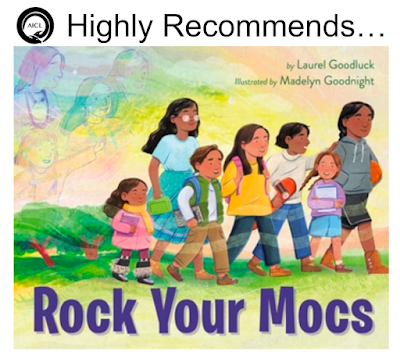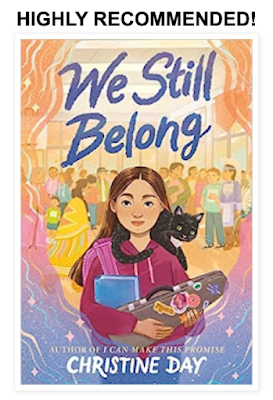When We Gather (Ostadahlisiha): A Cherokee Tribal Feast
Written by Andrea L. Rogers (Citizen of the Cherokee Nation)
Illustrated by Madelyn Goodnight (Citizen of the Chickasaw Nation)
Published by Heartdrum (HarperCollins)
Pub Year: 2024
Reviewer: Debbie Reese
Status: Highly Recommended
In professional development workshops that I do where I ask people to bring books with Native content, I look over what they've brought. Lots of old -- and not good -- nonfiction (series books and biographies) and fiction. I also see dreadful books by Paul Goble that look like they're Native, but they're not. A better way to describe them is "white man's Indian" which means a white imagining of Native life and culture.
More and more, in recent years, I see that someone has brought in a terrific book. An example is Jenny Kay Dupuis's I Am Not A Number. A librarian bought that one in last week. Another had Lindstrom and Goade's We Are Water Protectors. And another had Christine Day's biography of Maria Tall Chief. Terrific, for me, is books by Native writers who are writings stories from their own nation(s) and family experiences (like Jenny's), or who give readers a Native point of view on someone who has significance to Native communities (like Christine's), or that are set in the present day (like Carole and Michaela's).
Due out this week is another that I hope every library will add to their shelves. Of course, I'm talking about Andrea Rogers and Madelyn Goodnight's When We Gather (Ostadahlisiha): A Cherokee Tribal Feast.
Some things I love:
On the first page we see a luscious green landscape. Why does that matter? When they think "Native" a lot of people imagine deserts or plains. A face: Native people were, and are, everywhere.
In that lush landscape, a little girl is kneeling by a plant with slender leaves that rise up out of the grass. We'll come to know it is wild onions. The girl and her family set out harvesting them for a gathering at the community center where families have brought beans, grape dumplings stew, corn soup, and catfish for a wild onion dinner.
In that lush landscape, a little girl is kneeling by a plant with slender leaves that rise up out of the grass. We'll come to know it is wild onions. The girl and her family set out harvesting them for a gathering at the community center where families have brought beans, grape dumplings stew, corn soup, and catfish for a wild onion dinner.
I love seeing Native words in books! Just there, just part of the way it is. The clues are all there to know what Agilisi and Agiduda mean. And they're in a modern day house because, yeah, we are still here and it bugs us to have to say those words. Books like this one, though, help make that point.
Flipping to the author's note, I read that Rogers visited Cherokee homelands in Georgia. She tells us about the forced removal of the Cherokee, Creek, Chickasaw, Choctaw, and Seminole nations from the southeastern US. She also tells us about a special place: New Echota, their former capital. I call attention to "capital" because Americans associate that word with a state, but many do not know that we were, and are, sovereign nations. Rogers used "nation" but using additional words like "capital" help readers get further down that path of knowing what Native sovereignty means.
Any teacher or librarian that is doing something that is about family gatherings can add this book to that unit or program. And if you've got a way to do so, make some of the food you see in the book! Smith provides four recipes. Dig in!




